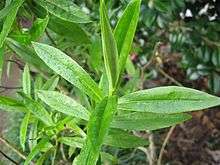Hebe breviracemosa
Hebe breviracemosa is a plant of the family Plantaginaceae native to Raoul Island of New Zealand's Kermadec Islands, where it is found in coastal cliffs and headlands.
| Hebe breviracemosa | |
|---|---|
 | |
| Scientific classification | |
| Kingdom: | Plantae |
| Clade: | Tracheophytes |
| Clade: | Angiosperms |
| Clade: | Eudicots |
| Clade: | Asterids |
| Order: | Lamiales |
| Family: | Plantaginaceae |
| Genus: | Hebe |
| Species: | H. breviracemosa |
| Binomial name | |
| Hebe breviracemosa Andersen 1926 | |
History
The species is very rare. It was once believed to have been consumed by goats to the point of extinction. When the island's last goat was shot in 1983, that same day a goat hunter discovered a single instance of the plant. It was the only example found in the wild until 1997, when, as part of a weed-eradication program, people searching the steep, volcanic cliffs of Raoul Island discovered fifty of the plants. Cuttings and seedlings raised from these plants are now being planted across Raoul Island. Nonetheless, the species still remains at severe risk of extinction, mainly through weed invasion of its unstable, volcanic cliff habitat.
Features
In warmer parts of the country, Hebe breviracemosa can flower throughout the year, while farther south it usually flowers in the summer months. Fruits can occur throughout the year but are more common in the summer.
